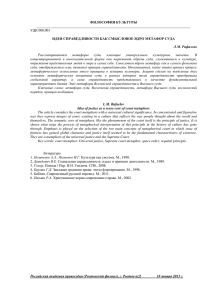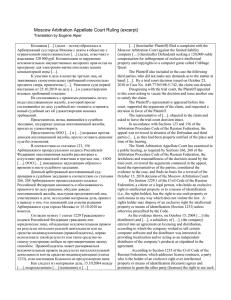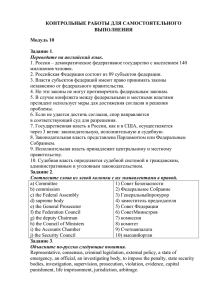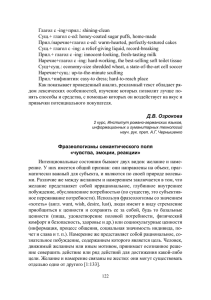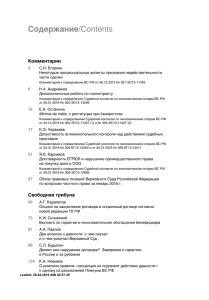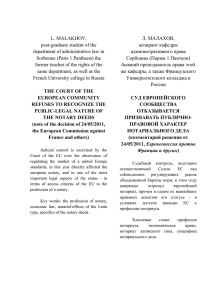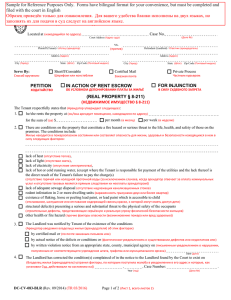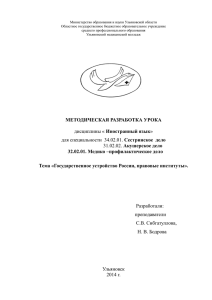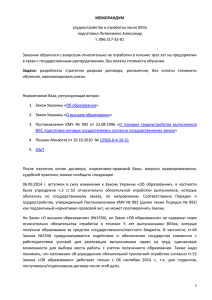![unit 3 THE SUPREME COURT OF THE RUSSIAN FEDERATION[1] (1) (1)](http://s1.studylib.ru/store/data/006535873_1-264eaec3640276892dd236bfe4585423-768x994.png)
UNIT 3. THE SUPREME COURT OF THE RUSSIAN FEDERATION Lead-in 1. Read and translate the following word combinations into Russian. Which of them refer to the Supreme Court of the Russian Federation? Explain your point of view using the phrases below. I think – я думаю I suppose – я полагаю I believe – я считаю If you ask me I’ll say that – если вы спросите меня, то я скажу, что To my mind – по моему мнению In my opinion – по моему мнению I’m not sure but it seems to me that – я не уверен, но мне кажется, что ● The highest appellate instance ● The constitutionality of draft laws ● Judicial chambers ● Trial by jury ● Supervisory instance ● The Plenary Session TEXT 2. Read and translate the text. THE SUPREME COURT OF THE RUSSIAN FEDERATION Essential Vocabulary 1. a court of original jurisdiction – суд первой инстанции 2. a court of supervisory instance – суд надзорной инстанции 3. to challenge legal acts - оспаривать законодательные акты 4. public authorities – органы государственной власти 5. to rule on the case – вынести решение по делу 6. to review the rulings of presidiums – пересмотреть постановления президиумов 7. to reverse judicial acts - отменить судебные акты 8. chambers of the Supreme Court – коллегии Верховного Суда 9. the Plenary Session of the Supreme Court – Пленум Верховного Суда 10. consideration of cases by way of supervision – рассмотрение дел в порядке надзора The Supreme Court of the Russian Federation is the highest judicial body for civil, criminal, administrative and other cases under jurisdiction of courts of general jurisdiction. Since 2014 the Supreme Court has been the highest appellate instance for economic disputes. Thus, according to Article 126 of the Constitution of the Russian Federation the Supreme Court carries out judicial supervision over the activities of courts of general jurisdiction and commercial courts. The Supreme Court of the Russian Federation has a right of legislative initiative on the issues within its competence. It also provides clarifications on the issues of judicial practice when it is required. 1 All the powers of the Supreme Court are enumerated in the federal constitutional law “On the Supreme Court of the Russian Federation”. The Supreme Court is the only court which combines the functions of a court of original jurisdiction, a court of appeal, a court of cassation and a court of supervisory instance. As a court of first instance, the Supreme Court considers administrative cases of particular importance or special public interest. The Supreme Court may challenge legal acts proposed by the President of the Russian Federation, the Government of the Russian Federation, the Central Election Commission and some other public authorities. It also resolves economic disputes between federal public authorities and public authorities of constituent entities of the Russian Federation. As a court of appellate instance, the Supreme Court reviews the decisions of supreme courts of constituent entities of the Russian Federation, which have not come into force yet. It also reviews the decisions of circuit military courts, which ruled on the cases as courts of original jurisdiction. It also serves as a court of appellate instance for its own decisions. As a court of cassation, the Supreme Court reviews the rulings of presidiums of supreme courts of constituent entities of the Russian Federation and of presidiums of circuit military courts, when they adopted the decisions as courts of appeal. As a court of supervisory instance, the Supreme Court supervises legality of the decisions made by lower courts. The Supreme Court may reverse or amend judicial acts, including its own acts, if they violate human rights and freedoms, guaranteed by the Constitution of the Russian Federation, and the universal principles of international law. The Supreme Court of the Russian Federation consists of 170 judges including chief justices and their deputies. The Supreme Court is composed of 7 chambers, the Plenary Session and the Presidium. The Plenary Session of the Supreme Court of the Russian Federation consists of all judges of the Supreme Court and is presided by the Chairman of the Supreme Court. The Plenary Session gives clarifications on the issues of judicial practice to other courts and resolves complicated disputes regarding the administration of justice and functioning of the judicial system of the Russian Federation. Apart from consideration of cases by way of supervision and upon newly discovered facts, the Presidium of the Supreme Court considers and hears issues related to the work of other judicial chambers and assists lower courts in correct application of the legislation. There are seven chambers in the structure of the Supreme Court of the Russian Federation: the Appellate Chamber, the Judicial Chamber on Administrative Cases, the Judicial Chamber on Civil Cases, the Judicial Chamber on Criminal Cases, the Judicial Chamber on Economic Disputes, the Judicial Chamber on Cases of the Military Personnel, the Disciplinary Chamber. The smooth functioning of each chamber makes the work of the Supreme Court effective and worthy of respect. Верховный суд Российской Федерации является высшим судебным органом по рассмотрению гражданских, уголовных, административных и иных дел, подведомственных судам общей юрисдикции. С 2014 года Верховный суд является высшей апелляционной инстанцией по экономическим спорам. Так, в соответствии со статьей 126 Конституции Российской Федерации Верховный Суд осуществляет судебный надзор за деятельностью судов общей юрисдикции и арбитражных судов. Верховный суд Российской Федерации 2 обладает правом законодательной инициативы по вопросам, входящим в его компетенцию. В нем также даются разъяснения по вопросам судебной практики, когда это требуется. Все полномочия Верховного Суда перечислены в Федеральном конституционном законе “О Верховном суде Российской Федерации”. Верховный суд является единственным судом, который сочетает в себе функции суда первой инстанции, апелляционного суда, кассационного суда и суда надзорной инстанции. В качестве суда первой инстанции Верховный суд рассматривает административные дела особой важности или представляющие особый общественный интерес. Верховный суд может оспаривать правовые акты, предложенные Президентом Российской Федерации, Правительством Российской Федерации, Центральной избирательной комиссией и некоторыми другими органами государственной власти. Он также разрешает экономические споры между федеральными органами государственной власти и органами государственной власти субъектов Российской Федерации. В качестве суда апелляционной инстанции Верховный суд пересматривает решения верховных судов субъектов Российской Федерации, которые еще не вступили в законную силу. Он также пересматривает решения окружных военных судов, которые рассматривали дела в качестве судов первой инстанции. Он также выступает в качестве суда апелляционной инстанции для принятия своих собственных решений. Являясь судом кассационной инстанции, Верховный суд пересматривает постановления президиумов верховных судов субъектов Российской Федерации и президиумов окружных военных судов, когда они принимали решения в качестве судов апелляционной инстанции. В качестве суда надзорной инстанции Верховный суд осуществляет надзор за законностью решений нижестоящих судов. Верховный суд может отменить или дополнить судебные акты, в том числе свои собственные акты, если они нарушают права и свободы человека, гарантированные Конституцией Российской Федерации, и универсальные принципы международного права. Верховный суд Российской Федерации состоит из 170 судей, включая председателей судов общей юрисдикции и их заместителей. Верховный суд состоит из 7 палат, пленарного заседания и Президиума. Пленарное заседание Верховного Суда Российской Федерации состоит из всех судей Верховного суда и проходит под председательством Председателя Верховного суда. Пленарное заседание дает разъяснения по вопросам судебной практики другим судам и разрешает сложные споры, касающиеся отправления правосудия и функционирования судебной системы Российской Федерации. Помимо рассмотрения дел в порядке надзора и по вновь открывшимся фактам, Президиум Верховного Суда рассматривает и заслушивает вопросы, связанные с работой других судебных палат, и оказывает содействие нижестоящим судам в правильном применении законодательства. В структуре Верховного Суда Российской Федерации семь палат: Апелляционная палата, Судебная палата по административным делам, Судебная палата по гражданским делам, Судебная палата по уголовным делам, Судебная палата по экономическим спорам, Судебная палата по делам военнослужащих, Дисциплинарная палата Камера. 3 Бесперебойное функционирование каждой палаты делает работу Верховного суда эффективной и заслуживающей уважения. 3. Give Russian equivalents to the following word combinations. 1. judicial supervision over the activities of courts 2. to provide clarifications on the issues of judicial practice 3. a court of original jurisdiction 4. to challenge legal acts 5. to review the decisions of circuit military courts 6. to adopt the decisions as courts of appeal 7. to reverse or amend judicial acts 8. a chief justice 9. consideration of cases upon newly discovered facts 10. the Appellate Chamber 1. судебный надзор 2. давать разъяснения по 3. суд 4. оспаривать 5. рассматривать решения 6. принимать за деятельностью вопросам судебной первой правовые окружных военных судов практики инстанции акты судов 4. Find English equivalents to the following word combinations in the text. 1. право законодательной инициативы 2. суд надзорной инстанции 3. рассматривать дела особой важности 4. разрешать экономические споры между органами государственной власти 5. вступить в силу 6. выступать в качестве суда апелляционной инстанции 7. нарушать права и свободы человека 8. Пленум Верховного Суда 9. отправление правосудия 10. судебная коллегия по уголовным делам 1. right of legislative initiative 2. court of supervisory instance 3. consider cases of particular importance 4. resolve economic disputes between government bodies 5. come into force 6. serve as a court of appellate instance 7. violate human rights and freedoms 8. Plenary Session of the Supreme Court 9. administration of justice 10. Judicial Chamber on Criminal Cases 5. Answer the questions. 1. What cases does the Supreme Court consider? 4 2. Where are the powers of the Supreme Court enumerated? 3. Does the Supreme Court have original jurisdiction? 4. What decisions does the Supreme court review as a court of appellate instance? 5. What are the functions of the Supreme Court as a court of cassation? 6. What are the powers of the Supreme Court as a court of supervisory instance? 7. What does the Supreme court consist of? 8. What is the Plenary Session of the Supreme Court? What does it do? 9. What is the role of the Presidium of the Supreme Court? 10. How many chambers are there in the Supreme Court? What are they? 1. The Supreme Court considers civil, criminal, administrative, and economic disputes, as well as cases related to the protection of rights and freedoms guaranteed by the constitution. 2. The powers of the Supreme Court are enumerated in the Constitution of the Russian Federation, federal constitutional laws, and federal laws. 3. Yes, the Supreme Court has original jurisdiction in economic disputes between federal authorities and authorities at the level of Russian Federation subjects. 4. The Supreme Court reviews decisions of supreme courts of Russian Federation subjects that have not entered into force as a court of appellate instance. 5. The functions of the Supreme Court as a court of cassation include reviewing rulings of lower courts to ensure correct application of law and procedural rules without re-examining the facts of the case. 6. The powers of the Supreme Court as a supervisory instance include overseeing the legality and uniformity of judicial practice, ensuring consistency in the interpretation and application of the law. 7. The Supreme Court consists of judicial chambers, an appellate chamber, a disciplinary chamber, the Plenum, and the Presidium of the Supreme Court. 8. The Plenary Session of the Supreme Court provides clarifications on issues of judicial practice, resolves complex disputes related to the administration of justice, and ensures uniformity in legal interpretation. 9. The Presidium of the Supreme Court reviews cases in the process of supervision and based on newly discovered circumstances, ensuring the correct application of law and protecting individuals' rights and freedoms. 10. There are several chambers in the Supreme Court, including judicial chambers, an appellate chamber, and a disciplinary chamber, each with specific functions and responsibilities. 6. Say whether the following statements are true or false. Correct the false statements. 1. Since 2014 the Supreme Court has been the highest appellate instance for economic disputes. 2. The Supreme Court cannot carry out judicial supervision over the activities of commercial courts. 3. The Supreme Court of the Russian Federation has a right of legislative initiative on the issues within the competence of the Federal Assembly. 4. The powers of the Supreme Court are enumerated in the constitution of the Russian Federation. 5. The Supreme Court combines the functions of a court of original jurisdiction, a court of appeal, a court of cassation and a court of supervisory instance. 6. The Supreme Court has a right to challenge legal acts proposed by the President of the Russian Federation, the Government of the Russian Federation, the Central Election Commission and some other public authorities. 5 7. As a court of appeal, the Supreme Court reviews the decisions of the commercial courts of constituent entities. 8. The Supreme Court has a right to reverse judicial acts, if they violate human rights and freedoms, guaranteed by the Constitution of the Russian Federation. 9. The Presidium of the Supreme Court gives clarifications on the issues of judicial practice to other courts. 10. There are eleven chambers in the Supreme Court, including the Plenary Session and the Presidium. 7. Fill in the gaps using the words from the box. Translate the sentences. legal acts, consideration of cases, judicial practice, judicial acts, original jurisdiction, constituent entities, administration of justice, appellate instance 1. The Supreme Court is the highest ______________ for economic disputes. 2. The Supreme Court provides clarifications on the issues of ___________________. 3. The Supreme Court combines the functions of a court of _________________, a court of appeal, a court of cassation and a court of supervisory instance. 4. The Supreme Court may challenge _____________ proposed by the President or the Government of the Russian Federation. 5. The Supreme Court resolves economic disputes between public authorities of ____________________ of the Russian Federation. 6. The Supreme Court may reverse or amend ____________, if they violate human rights and freedoms, guaranteed by the Constitution of the Russian Federation. 7. The Plenary Session resolves complicated disputes regarding the __________________ 8. The Presidium of the Supreme Court deals with ______________ by way of supervision and upon newly discovered facts. 1.appellateinstance 2.Judicialpractice 3.originaljurisdiction 4.legalacts 5.constituententities 6.judicialacts 7.administrationofjustice 8.considerationofcases Translations: 1. Верховный суд является высшей апелляционной инстанцией по экономическим спорам. 2. Верховный суд дает разъяснения по вопросам судебной практики. 3. Верховный суд сочетает функции суда первой инстанции, суда апелляционной инстанции, суда кассационной инстанции и суда надзорной инстанции. 4. Верховный суд может оспорить правовые акты, предложенные Президентом или Правительством Российской Федерации. 5. Верховный суд разрешает экономические споры между публичными органами субъектов Российской Федерации. 6. Верховный суд может отменить или изменить судебные акты, если они нарушают 6 права и свободы человека, гарантированные Конституцией Российской Федерации. 7. Пленум разрешает сложные споры, касающиеся управления правосудием. 8. Президиум Верховного суда занимается рассмотрением дел в порядке надзора и по вновь обнаруженным обстоятельствам. 8. Translate the following sentences into English. 1. Верховный Суд - это высшая апелляционная и кассационная инстанция по гражданским, уголовным и административным делам. 2. С 2014 года Верховный Суд является высшей апелляционной инстанцией по экономическим спорам. 3. Верховный Суд сочетает в себе функции суда первой инстанции, апелляционного суда, кассационного суда и суда надзорной инстанции. 4. Верховный Суд в качестве суда первой инстанции рассматривает экономические споры между органами федеральной власти и органами власти на уровне субъектов РФ. 5. В качестве апелляционной инстанции Верховный Суд пересматривает решения верховных судов субъектов РФ, которые не вступили в силу. 6. В качестве кассационной инстанции Верховный Суд пересматривает постановления президиумов окружных военных судов и президиумов верховных судов субъектов РФ. 7. Верховный Суд может отменить судебные акты, если те нарушают права и свободы, гарантированные конституцией. 8. В состав Верховного Суда входят судебные коллегии, апелляционная коллегия, дисциплинарная коллегия, Пленум и Президиум Верховного Суда. 9. Пленум Верховного Суда дает разъяснения по вопросам судебной практики. 10. Президиум Верховного Суда рассматривает дела в порядке надзора и по вновь открывшимся обстоятельствам. 1. The Supreme Court is the highest appellate and cassation instance for civil, criminal, and administrative cases. 2. Since 2014, the Supreme Court has been the highest appellate instance for economic disputes. 3. The Supreme Court combines the functions of a court of original jurisdiction, appellate court, cassation court, and supervisory court. 4. As a court of original jurisdiction, the Supreme Court considers economic disputes between federal authorities and authorities at the level of Russian Federation subjects. 5. As an appellate instance, the Supreme Court reviews decisions of supreme courts of Russian Federation subjects that have not entered into force. 6. As a cassation instance, the Supreme Court reviews rulings of the presidiums of district military courts and the presidiums of supreme courts of Russian Federation subjects. 7. The Supreme Court can annul judicial acts if they violate rights and freedoms guaranteed by the constitution. 8. The Supreme Court includes judicial chambers, an appellate chamber, a disciplinary chamber, the Plenum, and the Presidium of the Supreme Court. 9. The Plenum of the Supreme Court provides clarifications on issues of judicial practice. 10. The Presidium of the Supreme Court reviews cases through supervision and based on newly discovered circumstances. 9. Work in pairs. In turns ask questions about the Supreme Court and answer them. Try to cover the points below. 7 ● ● ● ● ● ● ● ● The functions of the Supreme Court The Supreme Court as a court of first instance The Supreme Court as a court of appeal The Supreme Court as a court of cassation The Supreme Court as a court of supervisory instance The Plenary Session of the Supreme Court The Presidium of the Supreme Court Function of the Supreme Court: Q1: What are the main functions of the Supreme Court? A1: The Supreme Court serves as the highest appellate and cassation instance for civil, criminal, and administrative cases. It also acts as a supervisory instance overseeing the legality and uniformity of judicial practice. The Supreme Court as a court of first instance: Q2: Can the Supreme Court act as a court of first instance? A2: Yes, the Supreme Court can serve as a court of first instance for certain cases, such as economic disputes between federal authorities and authorities at the level of Russian Federation subjects. The Supreme Court as a court of appeal: Q3: In what capacity does the Supreme Court function as a court of appeal? A3: The Supreme Court acts as a court of appeal by reviewing decisions of lower courts, such as the supreme courts of Russian Federation subjects that have not yet entered into force. The Supreme Court as a court of cassation: Q4: How does the Supreme Court function as a court of cassation? A4: As a court of cassation, the Supreme Court reviews rulings of lower courts to ensure correct application of law and procedural rules without reexamining the facts of the case. The Supreme Court as a court of supervisory instance: Q5: What is the role of the Supreme Court as a supervisory instance? A5: The Supreme Court acts as a supervisory instance to oversee the legality and uniformity of judicial practice, ensuring consistency in the interpretation and application of the law. The Plenary Session of the Supreme Court: Q6: What is the Plenary Session of the Supreme Court responsible for? A6: The Plenary Session of the Supreme Court provides clarifications on issues of judicial practice, resolves complex disputes related to the administration of justice, and ensures uniformity in legal interpretation. The Presidium of the Supreme Court: Q7: What is the function of the Presidium of the Supreme Court? A7: The Presidium of the Supreme Court reviews cases in the process of supervision and based on newly discovered circumstances, ensuring the correct application of law and protecting individuals' rights and freedoms. 8
